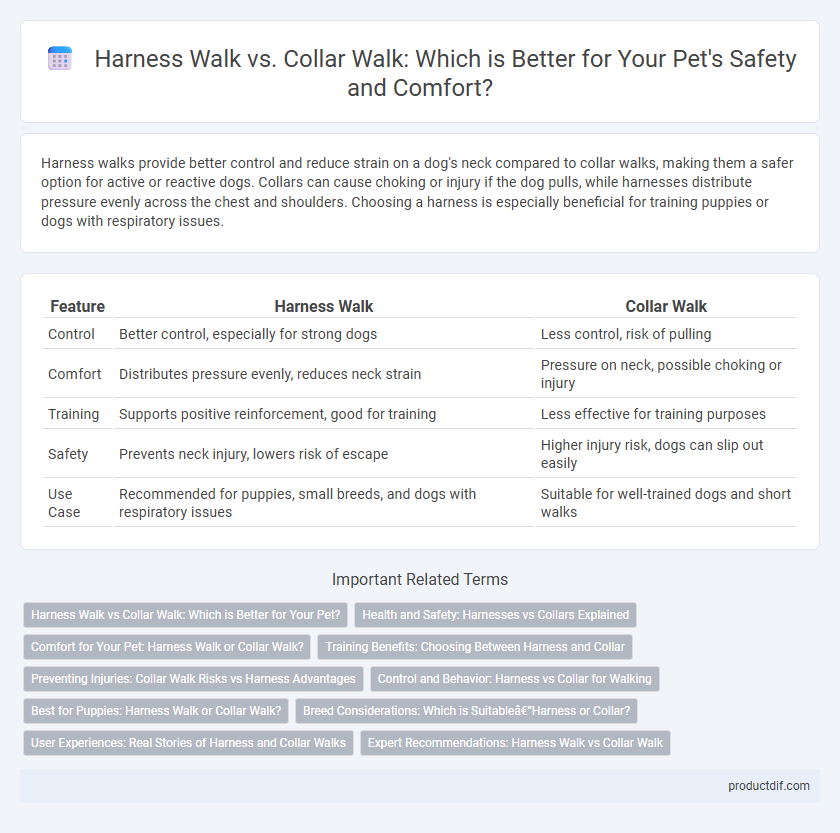Harness walks provide better control and reduce strain on a dog's neck compared to collar walks, making them a safer option for active or reactive dogs. Collars can cause choking or injury if the dog pulls, while harnesses distribute pressure evenly across the chest and shoulders. Choosing a harness is especially beneficial for training puppies or dogs with respiratory issues.
Table of Comparison
| Feature | Harness Walk | Collar Walk |
|---|---|---|
| Control | Better control, especially for strong dogs | Less control, risk of pulling |
| Comfort | Distributes pressure evenly, reduces neck strain | Pressure on neck, possible choking or injury |
| Training | Supports positive reinforcement, good for training | Less effective for training purposes |
| Safety | Prevents neck injury, lowers risk of escape | Higher injury risk, dogs can slip out easily |
| Use Case | Recommended for puppies, small breeds, and dogs with respiratory issues | Suitable for well-trained dogs and short walks |
Harness Walk vs Collar Walk: Which is Better for Your Pet?
Harness walks distribute pressure evenly across a pet's chest and back, reducing strain on the neck and minimizing the risk of injury, especially for small or brachycephalic breeds. Collar walks, while traditional, can cause choking or neck damage if the pet pulls, making them less suitable for dogs prone to pulling or with respiratory issues. Choosing between harness and collar depends on the pet's size, behavior, and health needs, with harnesses often recommended for safer, more comfortable control during walks.
Health and Safety: Harnesses vs Collars Explained
Harnesses distribute pressure across a dog's chest and shoulders, reducing the risk of neck strain and injury common with collars. Collars concentrate force on the neck, which can lead to tracheal damage or choking, especially in dogs prone to pulling. Choosing a harness enhances safety by preventing respiratory issues and offering better control during walks.
Comfort for Your Pet: Harness Walk or Collar Walk?
Harness walks provide superior comfort by distributing pressure evenly across the pet's chest and shoulders, reducing strain on the neck compared to collar walks. Collars can cause discomfort or injury, especially for dogs that pull or have respiratory issues, making harnesses a safer and more comfortable choice. Choosing a well-fitted harness enhances control and comfort, promoting a positive walking experience for pets of all sizes.
Training Benefits: Choosing Between Harness and Collar
Harness walks provide superior control and reduce strain on a dog's neck, making them ideal for training puppies or dogs prone to pulling. Collar walks allow more freedom of movement but require careful supervision to prevent choking or injury during training sessions. For effective leash training, harnesses offer safer, more consistent guidance that supports positive behavior reinforcement.
Preventing Injuries: Collar Walk Risks vs Harness Advantages
Harness walks reduce the risk of neck and throat injuries caused by collar walks, which can lead to tracheal damage, choking, or strain on a dog's cervical spine. Unlike collars, harnesses distribute pressure evenly across the chest and shoulders, minimizing the chance of injury during pulling or sudden movements. Studies show harnesses improve safety for dogs prone to respiratory issues or those with delicate neck anatomy.
Control and Behavior: Harness vs Collar for Walking
Harnesses provide superior control during walks by distributing pressure evenly across a dog's chest, reducing strain on the neck and minimizing the risk of injury, which is especially beneficial for dogs that tend to pull or have respiratory issues. Collars concentrate pressure on the neck and throat, potentially causing discomfort or injury if the dog pulls abruptly, but they offer less control compared to harnesses, making them less effective for managing strong or reactive dogs. Choosing a harness over a collar can improve behavior during walks by enabling gentler corrections and preventing choking or coughing episodes linked to collar use.
Best for Puppies: Harness Walk or Collar Walk?
Harness walks provide better control and reduce strain on a puppy's neck, making them ideal for young dogs prone to pulling or respiratory issues. Collars, while convenient for identification, can cause choking or injury if a puppy pulls excessively during walks. Experts recommend harnesses as the safest and most comfortable option for puppies during early training stages.
Breed Considerations: Which is Suitable—Harness or Collar?
Small dog breeds and brachycephalic breeds like Bulldogs often benefit more from harness walks, as harnesses distribute pressure evenly and reduce strain on their delicate necks and respiratory systems. Large, strong breeds such as German Shepherds may require harnesses designed for control and safety, while some active breeds accustomed to leash training may prefer collars for short walks. Understanding breed-specific anatomy and temperament helps pet owners select between harness and collar options that optimize comfort, safety, and effective training.
User Experiences: Real Stories of Harness and Collar Walks
Pet owners often share that harness walks provide greater control and comfort, reducing strain on their dog's neck and preventing choking, especially for active or pull-prone breeds. Collar walks, while simpler and quicker to use, can cause discomfort or injury when dogs pull hard, but some users report better leash responsiveness in trained pets. Real experiences highlight that harnesses enhance safety during long walks, whereas collars remain popular for quick outings and identification purposes.
Expert Recommendations: Harness Walk vs Collar Walk
Experts recommend harness walk over collar walk for enhanced safety and comfort, especially for dogs prone to pulling or respiratory issues. Harnesses distribute pressure evenly across the chest and shoulders, reducing the risk of neck injury that collars can cause during sudden pulls. Veterinarians and trainers emphasize using padded, adjustable harnesses to ensure proper fit and prevent chafing, promoting a more enjoyable walking experience.
Harness Walk vs Collar Walk Infographic

 productdif.com
productdif.com